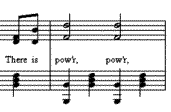Song Study: There Is Power In The Blood
This contents of these next few pages are probably what most readers are interested in, for this where we will explore improvising from music as it appears in a hymnal. The song we will be using is the well-known song There Is Power In The Blood.
Below is the song as it would appear in the hymnal. If you want to print this out and take it to the piano, then (1.) Click on the music to open it in a new window, and, (2.) Print the contents of the new window (select File, Print, etc.).
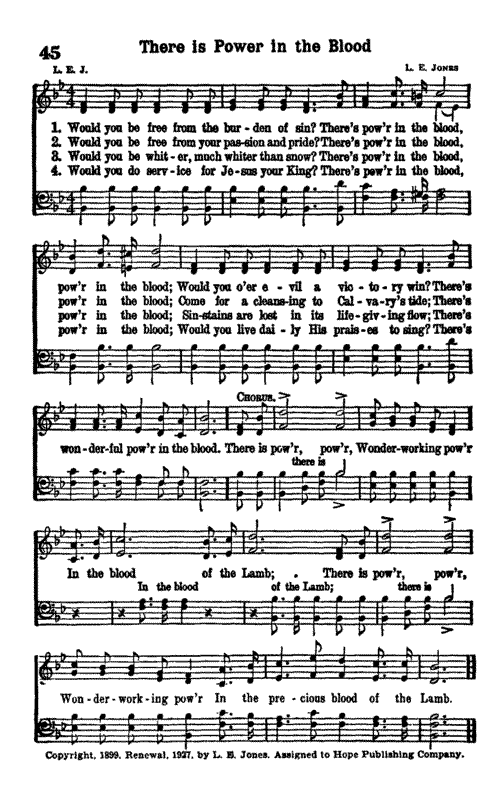
Applying The O/C
The general idea of how to apply the O/C to music does not change, whether playing from a hymnal, fake book, or by ear. In the earlier lessons, we simply played the melody with our right hand and the O/C in our left. We will follow these same principles to play hymns. The only differences are that we will be playing two notes with our right hand instead of one, and the chords are not marked for us.
 First Two Measures - Hymnal Version First Two Measures - O/C Version |
The first two measures of There Is Power In The Blood (as it would appear in a hymnal) is shown to the right. Below it is the O/C version of these same measures. Immediately you should notice that we have not changed the right hand at all. In the future we will make changes, but for now, our focus will be on playing the correct chord with the left hand.
Since hymnals were written for singers, not instrumentalists, rarely will chord symbols be printed in the music. This one fact frightens many pianists. They often resort to only playing from "their" book, in which they have already written the chord names above each measure, and they will often avoid playing unfamiliar songs. All of this can be avoided if one will learn a few simple guidelines to help determine which chord should be played.
First, look at the bass (lowest) note. Most of the time the Bass note will tell you the name of the chord. In this first measure, the Bass note is a Bb. To know for sure whether or not the chord is also Bb, compare the Tenor, Alto, and Soprano notes with the other notes of a Bb chord. In this case, the Tenor note is Bb, the Alto note is D, and the Soprano note is F. These three notes, Bb (in the Bass and Tenor), D, and F make up the Bb chord. Therefore, we know that we should use a Bb O/C until the notes change.
The notes do not change through the rest of the first measure, so we know that the chord will not change, either. The second measure is different, though. We have a new set of notes to look at. They are, beginning with the bass, Eb, Bb, Eb and G. Since the bass note is an Eb, the chord will probably be an Eb, too, but we need to double check this. The notes given are Eb, Bb, and G (ignoring the doubled notes). The tones that make up an Eb chord are Eb, G, and Bb. Since the notes in the music match what we recognize as an Eb chord, then the Eb O/C must be what we should play! (The order in which the notes are "stacked up" does not matter, and will not change the name of the chord. For example, even if the notes appeared in the order G, Bb, Eb, they would still be understood to be an Eb chord. We will talk about this more later.)
The notes change again on the third beat of the second measure. The bass goes back to a Bb, and the remaining notes are Bb, D, and F. The bass note gives us the clue that this might be a Bb chord, and the remaining notes, Bb, D, and F, confirm it. One could also look at the fact that these notes are the same as appear in the first measure, and therefore must be the same chord as the first measure.
The O/C And An Irregular Bass (Part 2)
Often the last stanza of a song's verse or chorus will have "irregular" bass movement. A few examples of this can be found in the last stanza of There Is Power In The Blood. Below is the hymnal version and O/C version of the last line.

Last Stanza - Hymnal Version Last Stanza - O/C Version |
On the third beat, on which we would play the octave, the chord is clearly indicated. We have a Bb, D, and F, which are the notes of a Bb Major Chord. The fourth beat (comprised of a dotted eighth and sixteenth note) is not so clear, however. The notes of the dotted eighth note (F, C, and A) indicate that an F Major chord should be played. The notes of the sixteenth note (F, D, Bb) however, require that a Bb Major chord be played.
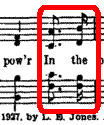 |
Obviously, with the limited time available to play this one beat in the course of the song, a compromise must be made. We must either play an F Major chord or a Bb Major chord on the fourth beat. In playing both possibilities, it should be clear that the Bb Major chord sounds better in this context, and should be the choice used to accompany the fourth beat.
Some pianists prefer a more analytical approach as to why the Bb Major chord should be used as opposed to the F Major chord. For this type of learner, I offer a more logical explanation: The first and third beat of a measure are the dominant beats, and the second and fourth are the weaker beats of a measure. In our example, on the third, stronger, beat, we play a Bb Octave (as indicated by the music). The fourth beat (in the hymnal version) temporarily moves to an F Major chord, but returns to the Bb Major chord within the same beat. Since the third beat is being played as a Bb Octave, then the fourth, weaker, beat should use the matching Bb Major chord. The F Major chord is merely a passing chord that, while not unimportant, is adequately implied by the movement of the Soprano and Alto voices. All in all, maintaining the Bb O/C pattern through the third and fourth beats delivers the desired effect and chordal support for the passage in question.
 |
Also in the last stanza is another common chording situation. In this example (taken from the second to last measure), the first and second beats use the F Major O/C pattern. The third beat, retains an F in the bass, but the notes (F, Bb, and D) are the notes of the Bb Major chord. The fourth beat is an easily recognizable F Major chord.
When examining what to play in a situation such as this, one should follow the music. The bass note given is an F, so an F O/C should be played. This does not contradict the Bb Major chord, which includes an F anyway, but it does allow a consistency to the flow of the bass line. It would not be advisable to play a Bb octave on the third beat, even though that is the chord named, because since the sustain pedal is held through the fourth beat, the Bb would be superimposed onto the F Major chord, which would not sound good at all.
Situations like this occur in almost every hymn, sometimes lasting only one beat, like the example cited, sometimes lasting two beats, and sometimes (but not often) lasting a measure or more. General guidelines are as follows:
- Play the bass note indicated, unless you have special reason to do otherwise.
- Play the chord indicated, remembering that the bass note does not always name the chord that needs to be played.
- Your ear is the final authority. Play what sounds best, and adjust if necessary.
The O/C And An Irregular Bass
Some may not feel that this next example is an irregular bass, but I refer to it as such because, first of all, the bass moves but the chord does not, and, secondly, the bass note does not name the chord being played.
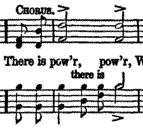 Chorus - Hymnal Version Chorus - O/C Version |
Look at this excerpt taken from the beginning of the Chorus. In particular, we are looking at the portion in which the bass and tenor repeat the words "there is pow'r." As you can see in the illustration, there are two eighth notes on the second beat of this measure (just like in the beginning of the song). What makes this measure different is that the eighth notes are changing in the bass. As such, we will deal with them separately, and then go from there.
Look at the first complete measure shown (not the pickup beat). The first of the pair of eight notes has a D in the bass. Normally, this would indicate a D chord, but the remaining notes, Bb, F, and D (the soprano and alto notes are held over from the first beat), tell us that this is a Bb chord. The second eighth note has an F for the bass. Normally, this would indicate an F chord, but, again, the remaining notes (Bb, F, and D), require that this be a Bb chord as well. Therefore, we know that the second beat of this measure is a common Bb chord.
Upon recognizing that the chord does not actually change despite the variation in the bass, it should be but a simple step to apply the O/C to this musical example. The O/C version is provided below the hymnal version.
How Should It Sound?
Below is the song as it would appear being played with the O/C. If you want to print this out and take it to the piano, then (1.) Click on the music to open it in a new window, and, (2.) Print the contents of the new window (select File, Print, etc.). Please remember, though, that your goal is not to play from this piece of music. Your goal is to play this (or something similar) by looking at and interpreting the music as it appears in the hymnal. This version is only for reference!
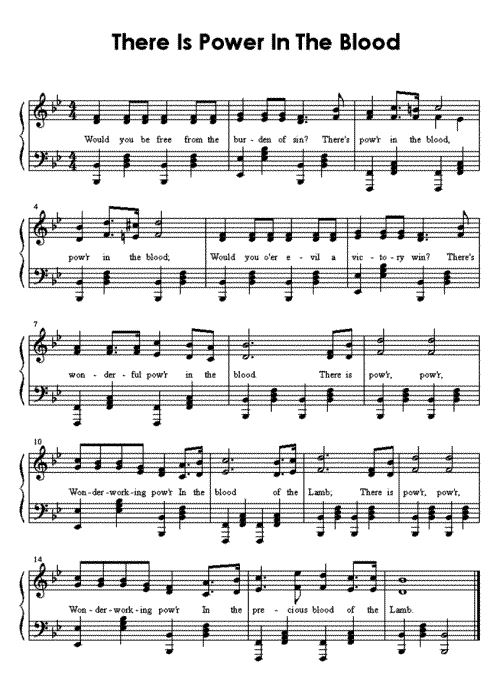
One final aspect that should be addressed is the style in which this music should be played. There are two schools of thought on this, which differs widely from church to church, denomination to denomination, and even different geographical regions.
The first method is usually found in liturgical churches among classically trained musicians. These demand a strict adherence to meter and rhythm, with every note rhythm sounding exactly as it is written. Often this is referred to as "straight eighths" (as opposed to "swung eighths", which will be discussed next). Interestingly enough, it is often classical players who resist improvisation the most, since it's "inexactness" is contradictory to the specific nature of classical music. This style can be heard in the MIDI file below.
| Example 1: There Is Power In The Blood There Is Power In The Blood - Traditional Rhythm |
The second method is usually found in less formal churches. It makes use of a swung rhythm when playing eighths or dotted eighths and sixteenths, which is why it is usually referred to as "swung eighths". Instead of each eight note receiving half of the beat, the first receives about 2/3 of the beat, and the second receives the remaining third of the beat. This effect can be approximated by saying "Hump-ty Dump-ty". Often the dotted eighth and sixteenth note rhythms receive the same treatment, making them indistinguishable from eighth notes. Unfortunately, this modification of how the beats are divided has caused some to equate this style with jazz. While swung eights are indeed common to jazz, they are by no means exclusive to jazz, and should not be regarded as such. This "free-er" interpretation produces a light, happy style, which is very effective when used appropriately. This style can be heard in the MIDI file below.
| Example 2: There Is Power In The Blood
There Is Power In The Blood - Swung Rhythm |
After explaining the two styles, I am often asked which is best when playing in church. Personally, I use both methods, depending on the song and mood needed to be conveyed. Soft, slow music lends itself to the simpler, liturgical style. Faster, happy music lends itself to the swung style. As always the ear is your guide, so listen to what you are playing, and work until you are happy with what you hear.
Closing Remarks
Many people fall in love with the O/C style when they first begin learning it. Others see it as monotonous, and do not care for it. To both I would urge that you remember that what you see in this lesson is only the first step. We will continue to build on the basic O/C until our left and right hands are both playing spectacular runs and fills... we just have to start somewhere. Always remember that there are many great things yet to come!
Remember that you cannot learn how to play hymns by reading these lessons. You can only learn by doing (or, playing, that is)! These lessons are a guide to help in your own explorations into evangelistic improvisation. Learn this song so that it can be played without any hesitations. Use a Metronome to help you to keep a steady tempo. And finally, pick out more hymns on your own and try to play them with the O/C. Become familiar enough with the O/C pattern that you can play it without watching your left hand. Only then will you be ready to move on to the next step of hymn playing.


